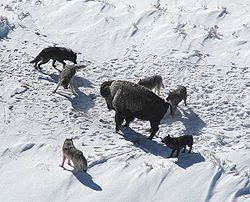Presociality
Presociality is a term which applies to animal behaviour. Presocial animals have close family relationships, more than just sexual interactions with members of the same species. However, they do not form the extreme colonies of eusocial insects, such as ants.


Presocial animals can live together and take care of their young. They may have some division of labor, but they do not have all the three essential traits of eusocial animals, which are:
- There are many generations that are alive at the same time.
- There is extreme division of labour. Some animals may be specialised for a certain function. Some animals may be sterile.
- The older animals cooperate to care for the young.
Presocial behavior is much more common in the animal kingdom than complete eusociality. Examples include canines that live in packs, numerous insects, especially hymenoptera, humans, many birds, chimpanzees, and many other animals that display social behavior.
The concept of presociality can be further divided:
- Subsocial: parents interact with young. This applies to all mammals without exception, almost all birds, many reptiles and fish, and quite a few insects.
- Parasocial: individuals of the same generation live in a single, cooperative dwelling and interact with each other
- Communal: each individual care exclusively for her or his own young
- Quasisocial: individuals care cooperatively for all brood; however, all members of the colony are reproductive
- Semisocial: a few individuals reproduce, yet the arrangement is not quite eusocial. For example, adult generations might not overlap, the reproductive dominance might be temporary.
Among the Vespid wasps, the pressures of predators and parasites selected subsocial behaviour. It is easier to guard the eggs and grubs when the mother wasp stays in her nest to watch over her larva. More so if other adults stay with her. Then the other adults need to collect more food than just for themselves. And so on. It becomes less likely that parasites will be successful in preying on the nest.[1]
Related pages
changeReferences
change- ↑ Ross, Kenneth G and Robert W. Matthews. 1991. The social biology of wasps. Comstock. Ithaca, New York.